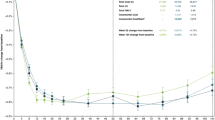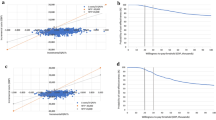Abstract
Introduction: Recent clinical trial results have demonstrated that, in patients with type 2 diabetes, second-line treatment of rosiglitazone in combination with metformin can lead to significant improvements in the control of fasting plasma glucose/glycosylated haemoglobin A1c (HbA1c) after the failure of metformin monotherapy. Our objective was to assess the cost-effectiveness of the use of rosiglitazone in combination with metformin in overweight and obese patients with type 2 diabetes in the UK, failing to maintain glycaemic control with metformin monotherapy compared with conventional care using metformin in combination with sulfonylurea.
Methods: The Diabetes Decision Analysis of Cost — type 2 (DiDACT) model, an established long-term economic model of type 2 diabetes, which projects the relationship between treatment and HbA1c over extended periods, was used to determine the health outcomes and economic impact for matched age and sex cohorts of 1000 patients with type 2 diabetes. The perspective was that of the UK National Health Service and all costs were in UK pounds sterling.
Results: Treatment with rosiglitazone in combination with metformin provides better glycaemic control over the remaining lifetime of patients than metformin and sulfonylurea combination therapy. Patients treated with rosiglitazone combination therapy were predicted to have a longer life expectancy, gaining 123 and 140 additional life years per 1000 patients in the obese and overweight cohorts, respectively. Improvements in morbidity and a delay in the start of insulin therapy resulted in a projected improvement in quality of life. These effects combine with projected improved survival to yield 131 and 209 additional quality-adjusted life-years (QALYs) per 1000 patients in the obese and overweight cohorts, respectively. Discounted incremental cost-effectiveness ratios were estimated at £16 700 per QALY gained for the obese cohort and £11 600 per QALY gained for the overweight cohort.
Conclusion: The model predicts that rosiglitazone in combination with metformin is a cost-effective treatment in the UK for both obese and overweight patients failing on metformin monotherapy, compared with conventional therapy using metformin in combination with sulfonylurea.
Similar content being viewed by others
References
International Diabetes Federation. Diabetes Atlas 2001. Edition Brussels: International Diabetes Federation 2001
Department of Health. National service framework for diabetes: standards. London; Department of Health 2001
Amos AF, McCarty DJ, Zimmet T. The rising global burden of diabetes and its complications: estimates and projections to the year. Diabet Med 1997; 14 (Suppl. 5): S1–85
Currie CJ. NHS acute sector expenditure: the present, future, and excess in-patient cost of care. Diabet Med 1997; 14: 686–92
HM Treasury. Budget 2004: prudence for a purpose: a Britain of stability and strength: economic and fiscal strategy report and financial statement and budget report-March 2004. London; Stationery Office 2004.
DeFronzo RA, Bonadonna RC, Ferrannini E. Pathogenesis of NIDDM: a balanced overview. Diabetes Care 1992; 15: 318–68
Klein R. Hyperglycaemia and microvascular and macrovascular disease in diabetes. Diabetes Care 1995; 18: 258–68
Pirart J. Diabetes mellitus and its degenerative complications: a prospective study of 4,400 patients observed between 1947 and 1973 part 1). Diabetes Care 1977; 3: 245–56
Stratton IM, Adler AI, Neil HA, et al. Association of glycaemia with macrovascular and microvascular complications of type 2 diabetes (UKPDS 35): prospective observational study. BMJ 2000; 321: 405–12
UK Prospective Diabetes Study (UKPDS) Group. Intensive blood-glucose control with sulphonylureas or insulin compared with conventional treatment and risk of complications in patients with type 2 diabetes (UKPDS 33). Lancet 1998; 352: 837–53
UK Prospective Diabetes Study (UKPDS) Group. Effect of intensive blood glucose control with metformin on complications in overweight patients with type 2 diabetes (UKPDS 34). Lancet 1998; 352: 854–65
Nolan JJ, Jones NP, Patwardhan R, et al. Rosiglitazone taken once daily provides effective glycaemic control in patients with type 2 diabetes mellitus. Diabet Med 2000; 17: 287–94
Hallsten K, Virtanen KA, Lonnqvist F, et al. Rosiglitazone but not metformin enhances insulin and exercise-stimulated skeletal muscle glucose uptake in patients with newly diagnosed type 2 diabetes. Diabetes 2002; 51: 3479–85
Virtanen KA, Hallsten K, Parkkola R, et al. Differential effects of rosiglitazone and metformin on adipose tissue distribution and glucose uptake in type 2 diabetic subjects. Diabetes 2003; 52: 283–90
Lebovitz HE, Dole JF, Patwardhan R, et al. Rosiglitazone monotherapy is effective in patients with type 2 diabetes. J Clin Endocrinol Metab 2001; 86: 280–8
Nadra AR, Ambery PD, Freeman K, et al. Rosiglitazone in combination with metformin: efficacy and safety in daily practice. Diabet Med 2004; 21 (Suppl. 2): P118
Jariwala S, Mather R, Walker L, et al. Long-term glycaemic control with rosiglitazone in combination with metformin. Diabet Med 2003; 20 (Suppl. 2): P277
Approval letter for new drug application (NDA 21-071), 1999. Available at: http://www.fda.gov/cder/foi/appletter/1999/21071ltr.pdf. [Accessed 2005 Jan 6]
Approval letter for new drug application (NDA 21-071/S-001), 2000. Available at: http://www.fda.gov/cder/foi/appletter/2000/21071S1LTR.PDF. [Accessed 2005 Jan 6]
Krentz AJ, Bailey CJ, Melander A. Thiazolidinediones for type 2 diabetes [Editorial]. BMJ 2000; 321: 252–3
Guidance on the use of glitazones for the treatment of type 2 diabetes. National Institute for Clinical Excellence, 2003. Available at: http://www.nice.org.uk/page.aspx?o=83270.
Czoski-Murray C, Warren E, Chilcott J, et al. Clinical effectiveness and cost-effectiveness of pioglitazone and rosiglitazone in the treatment of type 2 diabetes: a systematic review and economic evaluation. Tunbridge wells; Gray Publishing 2004 v.8, pt 13 4275.224200
Bagust A, Hopkinson PK, Waier W, et al. An economic model of the long-term health care burden of type II diabetes. Diabetologia 2001; 44: 2140–55
Bagust A, Evans M, Beale S, et al. A model of long-term metabolic progression of type 2 diabetes mellitus for evaluating treatment strategies. Pharmacoeconomics 2006; 24 (Suppl. 1): 5–19
Stevens RJ, Kothari V, Adler AI, et al. on behalf of the United Kingdom Prospective Diabetes Study (UKPDS) Group. The UKPDS risk engine: a model for the risk of coronary heart disease in type II diabetes (UKPDS 56). Clin Sci 2001; 101: 671–9
Kothari V, Stevens RJ, Adler AI, et al. for the UK Prospective Diabetes Study Group. UKPDS 60: risk of stroke in type 2 diabetes estimated by the UK Prospective Diabetes Risk Engine. Stroke 2002; 33: 1776–81
Bagust A, Beale S. Modelling EuroQol health-related utility values for diabetic complications from CODE-2 data. Health Econ 2005; 14: 217–30
Campbell IW. Antidiabetic drugs present and future: will improving insulin resistance benefit cardiovascular risk in type 2 diabetes? Drugs 2000; 60: 1017–28
Kirpichnikov D, McFarlane SI, Sowers JR. Metformin: an update. Ann Intern Med 2002; 137: 25–33
De Fronzo RA, Goodman AM. Metformin Multicenter Study Group. Efficacy of metformin in patients with non-insulin-dependent diabetes mellitus. N Engl J Med 1995; 33: 541–9
GlaxoSmithKline. Data on File (1). 2003
Levy JC, Matthews DR, Hermans MP. Correct Homeostasis Model Assessment (HOMA) evaluation uses the computer program [Letter]. Diabetes Care 1998; 21: 2191–2
GlaxoSmithKline. Data on File (2). 1998
GlaxoSmithKline. Data on File (3). 1998
GlaxoSmithKline. Data on File (4). 1998
GlaxoSmithKline. Data on File (5). 1998
GlaxoSmithKline. Data on File (6). 2001
Jones NP, Mather R, Owen S, et al. Rosiglitazone: long-term efficacy in combination with metformin or as monotherapy. Diabetes Res Clin Pract 2000; 50 (Suppl. 1): P307
Campbell KR, White JR. Medical Management of Type 2 Diabetes. American Diabetes Association 1998; 100–31
Freed M, Ratner R, Marcovina SM, et al. Effects of rosiglitazone alone and in combination with atorvastatin on the metabolic abnormalities in type 2 diabetes mellitus. Am J Cardiol 2002; 90: 947–52
Schaefer E, Gould E. Rosiglitazone increases high-density lipoprotein cholesterol levels in patients with type 2 diabetes. Presented at 52nd Annual Scientific Session American College of Cardiology. Chicago, IL, 2 April 2003
Jones NP, Mather R, Owen S, et al. Long-term efficacy of rosiglitazone as monotherapy or in combination with metformin [abstract]. Diabetalogia 2000; 43 (Suppl. 1): A192
Eastman RC, Javitt JC, Herman WH, et al. Model of cmplications of NIDDM. II Analysis of the health benefits and cost-effectiveness of treating NIDDM with the goal of normoglycemia. Diabetes Care 1997; 20: 735–43
Eastman RC, Javitt JC, Herman WH, et al. Model of cmplictations of NIDDM. I Model construction and assumptions. Diabetes Care 1997; 20: 725–33
St John Sutton M, Rendell M, Dandona P. A comparison of the effects of rosiglitazone and glyburide on cardiovascular function and glycemic control in patients with type 2 diabetes. Diabetes Care 2002; 25: 2058–64
National Institute for Clinical Excellence. Management of type 2 diabetes — management of blood pressure and blood lipids (Guideline H). National Institute for Clinical Excellence 2002
Third Joint Task Force of European and other Societies on Cardiovascular Disease Prevention in Clinical Practice. European guidelines on cardiovascular disease prevention in clinical practice. Eur Heart J 2003; 24 1601–10
Retail Prices Index: monthly index numbers of retail prices 1948–2005 (RPI) (RPIX). Available at: www.statistics.gov.uk. [Accessed 2005 Aug 18]
British Medical Association Royal Pharmaceutical Society of Great Britain. BNF 46. Edition 2003
Chartered Institute of Public Finance and Accountancy (CIPFA). The Health Service Database and Comparator Tool 2001. Institute of Public Finance Ltd 2002
Department of Health. NHS Reference Costs 2002. Department of Health 2002
Netton A, Curtis L. Unit costs of health and social care 2003. University of Kent at Canterbury, UK, 2003.
Evans JM, MacDonald TM, Leese GP, et al. Impact of type 1 and type 2 diabetes on patterns and costs of drug prescribing. Diabetes Care 2000; 23: 770–4
National Institute for Clinical Excellence. Management of type 2 diabetes — managing blood glucose levels. National Institute for Clinical Excellence, London, UK, 2002.
Mata M, Antoñ-anzas F, Tafalla M, Sanz P. El coste de la diabetes tipo 2 en España. El estudio CODE-2. [in Spanish]. Gac Sanit 2002; 16: 511–20
Liebl A, Neiss A, Spannheimer A, et al. Conmplications, comorbidity, and blood glucose control in type 2 diabetes mellitus patients in Germany — results from the CODE-2 study. Exp Clin Endocrinol Diabetes 2002; 110: 10–6
National Institute for Clinical Excellence. Guide to the Methods of Technology Appraisal. National Institute for Clinical Excellence, London, UK, 2004.
McIntosh A, Hutchinson A, Home PD, et al. Clinical guidelines and evidence review for Type 2 Diabetes: Blood glucose management. Sheffield: ScHARR, University of Sheffield 2001.
Raftery J. NICE: faster access to modern treatments? Analysis of guidance on health technologies BMJ 2001; 323: 1300–3
Stynes G, Tilden D, Swift M, et al. The cost-effectiveness of pioglitazone in combination with metformin in the treatment of type 2 diabetes mellitus in Scotland. ISPOR 7th Annual European Congress. Hamburg, Germany, 24–26 October 2004 [Poster presentation]
Neeser K, Lubben G, Siebert U, Schramm W. Cost effectiveness of combination therapy with pioglitazone for type 2 diabetes mellitus from a German statutory healthcare perspective. Pharmacoeconomics 2004; 22: 321–41
Turner RC, Cull CA, Frighi V, et al. Glycemic control with diet, sulfonylurea, metformin, or insulin in patients with type 2 diabetes mellitus, Progressive requirements for multiple therapies (UKPDS 49). JAMA 1999; 281: 2005–12
Ralston S, Mera R, Wisner C, et al. Quality of life and treatment satisfaction of type 2 diabetic patients: the CODE-2 experience. Diabetologia 2000; 43 (Suppl. 1): A225
Tannock LR, Little PJ, Tsoi C, et al. Thiazolidinediones reduce the LDL binding affinity of non-human primate vascular cell proteoglycans. Diabetologia 2004; 47: 837–43
Drummond MF, O’Brien B, Stoddart GL, et al. Cost analysis. In: Methods for economic evaluation of health care programs. 2nd ed. Oxford: Oxford University Press; 1977
Gold MR, Siegel JE, Russell LB, et al. Cost-effectiveness in health and medicine. New York: Edition Oxford University Press; 1996
Author information
Authors and Affiliations
Corresponding author
Rights and permissions
About this article
Cite this article
Beale, S., Bagust, A., Shearer, A.T. et al. Cost-effectiveness of Rosiglitazone Combination Therapy for the Treatment of Type 2 Diabetes Mellitus in the UK. PharmacoEconomics 24 (Suppl 1), 21–34 (2006). https://doi.org/10.2165/00019053-200624001-00003
Published:
Issue Date:
DOI: https://doi.org/10.2165/00019053-200624001-00003




